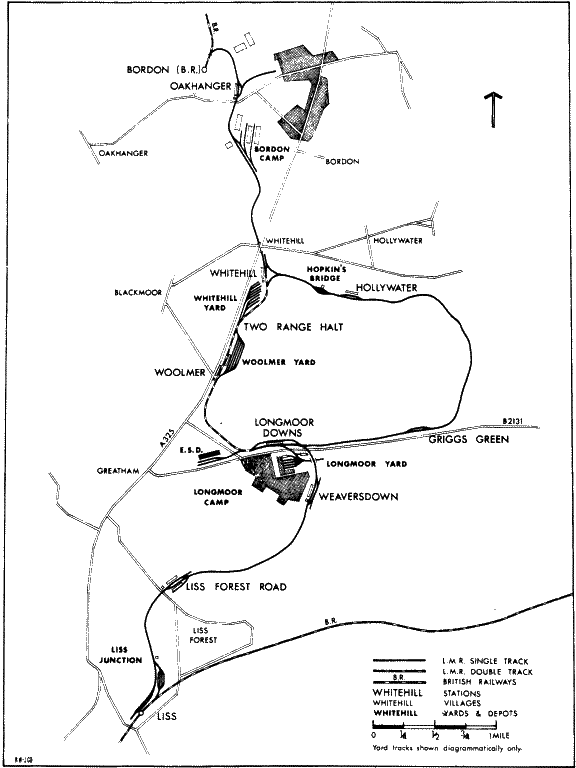
| THE INDUSTRIAL RAILWAY RECORD |
© MARCH 1966 |
LONGMOOR
MILITARY
RAILWAY
KEITH FARMER
(Articles dealing with the history of the Army’s famous training railway at Longmoor in Hampshire have appeared elsewhere (‘The Locomotive’ for 1930, "The Railway Gazette" for 1932 and "The Railway Observer" for 1958) but we are pleased to publish this account of the situation as it was in August 1963 when the author explored the railway whilst on a fortnight’s training course.
Railway activities at Longmoor date from 1903 when a 1ft 6in gauge tramway was laid to assist in removing bodily about seventy corrugated iron huts from Longmoor Camp to Bordon. Relaid to standard gauge in 1905-1907 it became known as the Woolmer Instructional Military Railway, but reverted to its present title in 1935. The Liss extension was opened in 1933, and the branch from Whitehill via Hollywater to Longmoor was completed in 1942. Well over a thou sand locomotives have had associations with the Railway (even though many went only for storage) but we do not have the full story by any means. Reminiscences from "old sweats" are welcomed, as well as details of the present position. - Hon. Eds.)
The southern terminus of the Longmoor Military Railway is at Liss where, adjacent to the British Railways station, is what the small sign proclaims to be Liss L.M.R. This is only the passenger terminus and consists of a run-round loop, single platform and small shelter. Half a mile from Liss, at Liss Junction, a line diverges to the Liss exchange sidings. At their southern end these sidings converge on a single track which leads through a gate into the B.R. yard at Liss. A small signal box, or blockpost as the Army prefers to call it, controls access to the sidings, but is normally shut up as the sidings are rarely used. The next station north is Liss Forest Road - one and a quarter miles from Liss - situated by a small road to Liss Forest village. As well as a level crossing there is a passing loop, two platforms, a signal box and a spur to a sand drag in each direction. The box here is also normally closed and the loop set for a through run. However, the box and loop are always used when training is in progress.
There is one more station before Longmoor - Weaversdown Halt - which serves the eastern side of Longmoor Camp, and was once a passing place. The loop is locked for a straight through run, however, and the signalling system has been dismantled. Between Weaversdown and Longmoor the line traverses a long left hand curve which changes its direction from north-east to west and crosses the east end of Longmoor Yard on a single span girder bridge and the B 2131 Liphook - Greatham road on the level.
Longmoor Downs station, as might be expected, is the largest on the railway, and is separated from the rest of Longmoor Camp by the Liphook - Greatham road. The station consists of a large island platform, situated between a number of tracks, with a brick signal box in the middle, The box has an 80 lever interlocking frame and controls lines in five directions, To the east is the main line to Liss; to the south-east is the lime to Longmoor Yard; to the west is the siding into the Engineer Stores Depot attached to Longmoor Camp; to the north-west is the main line to Bordon; and finally to the north-east is the Hollywater Branch. Longmoor Downs station has two tracks to the north and three to the south. These converge at the western end of the station into the main line to Bordon. Although this is double track as far as Whitehill, it is worked double line only when training is in progress. An indicator in Longmoor station shows whether it is being worked single or double line.

Between Longmoor and Whitehill are two intermediate stations, Woolmer and Two Range Halt. Woolmer station has two staggered platforms, and a box controlling the southern entrance to Woolmer Yard. The latter consists of five sidings running parallel with the main line and converging on Two Range Halt Box. The box is all that marks the halt and takes its name from the nearby number two rifle range; it also controls access to Whitehill Yard. The latter was opened during the Second World War and is now disused, the tracks being covered with brambles and small bushes. Half a mile from Two Range Halt is Whitehill Station, where the Army have their own peculiar kind of signalling which makes use of red and green flags.
Whitehill station has a small platform on the west side, and is the northern junction of the Hollywater Branch which makes a triangular junction with the eastern track of the main line. To allow for single line working, therefore, crossovers are provided in the station layout. These crossovers are also necessary because the eastern track ends just north of its junction with the northern side of the triangle. Just north of Whitehill Station the line passes under the only overbridge on the railway and then commences a stiff climb through wooded land towards the next station, Oakhanger. Half a mile from Oakhanger, however, a long siding leaves the main line towards the south and trails back to a reversing junction at a lower level. From the reversing junction sidings branch out into one of the stores areas of Bordon Camp.
Oakhanger station also has a single platform on the west side of a loop. At the south end of the station there is a level crossing with the B 3002 Bordon - Lindford road and this, in common with all level crossings on the railway, is ungated. From the loop a siding runs off into another part of Bordon Camp. The final half mile of the main line swings it round through 180 degrees to bring it to the end of the B.R. branch from Bentley, where there are passenger and freight interchange facilities.
As previously mentioned Whitehill is the northern junction of the Hollywater Branch. The two sides of the triangle converge after two hundred yards, and the branch then runs roughly due east towards Hopkin’s Bridge. On approaching Hopkin’s Bridge, three quarters of a mile from Whitehill, the branch swings sharply to the right round the edge of a clearing in otherwise dense woodland. A siding, however, continues straight ahead, and divides into two before ending abruptly on the edge of a deep pit, about 100 yards across; on the other side the two sidings resume and eventually rejoin the branch. This pit has a rough track running into it on the far side from the branch and is used for practise in bridge construction. However, I believe that on occasions the re−railing loco No. 178 has been tipped off the end of one of these sidings and it has then been the job of the trainees to get it back on the track.
From Hopkin’s Bridge the branch runs east for a further quarter of a mile to Hollywater station where there is a loop on the left hand side of the main running line and a platform constructed from old sleepers. The loop has large piles of ash dumped on it and has been disused for some time, the points being locked for a through run. Beyond Hollywater the branch climbs steeply before Griggs Green, three miles from Whitehill. The spot is marked by a short disused loop on the right hand side, and at this point the Liphook - Greathan road becomes visible on the left hand side. The branch parallels the road for one mile and then cuts round the side of a small hillock to join the Liss line at the approach to Longmoor Downs station. In general the track on the branch is in poor condition - in marked contrast to the rest of the railway - as it is only used for training runs at odd intervals.
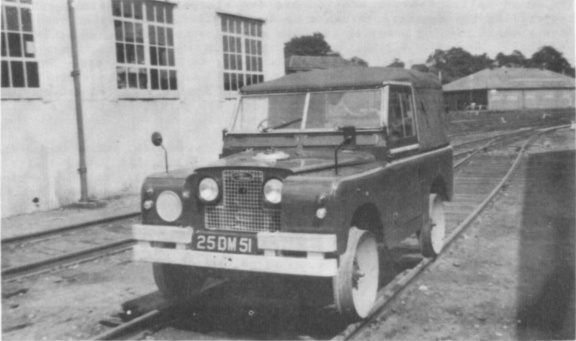
Experimental Land Rover conversion at Longmoor in August 1963. (Author)
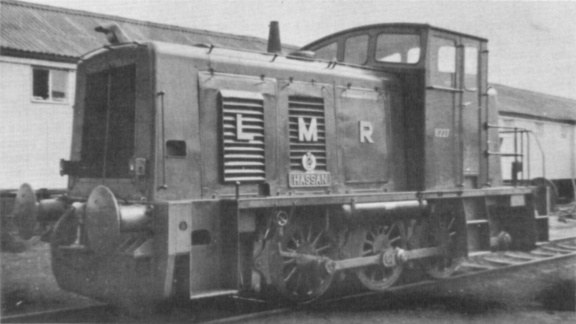
Ruston Hornsby diesel locomotive 8227 HASSAN at Longmoor in August 1963. (Author)
The regular services are a slight increase on what has been standard for two or three years. 0m weekdays there are eleven passenger trains each way between Longmoor and Liss, and a freight service between Longmoor and Bordon which runs as required. The latter is mainly to bring in locomotive coal and supplies to the Engineer Stores Depot attached to Longmoor Camp. The passenger timetable introduced on 22nd July 1963 gave the following service:-
DOWN TRAINS
Longmoor: dep. 06.42A, 07.35A, 08.25A, 09.16B(WX), 10.16B(WX), 11.16B(WX), 12.40A(WX), 14.16B(WX), 15.16B(WX), 16.35A(F) and 17.15A. Trains call at Weaversdown and Liss Forest Road, and arrive at Liss 3, 9 and 14 minutes respectively after leaving Longmoor.
UP TRAINS
Liss:- dep. 07.15A, 07.55A, 08.45A, 09.45B(WX), 10.45B(WX), 11.45B(WX), 13.45A(WX), 14.45B(WX), 15.45B(WX), 16.55A(F) and 17.45A. Trains call at Liss Forest Road and Weaversdown, and arrive at Longmoor 4, 10 and 14 minutes respectively after leaving Liss.
NOTES F - On Fridays the 16.35 Down and 16.55 Up run 23 and 20 minutes earlier respectively.
WX - Wednesdays excepted.
The ‘A’ services are timed to connect with B.R. trains and are principally for the many civilians employed at the camp who travel by train to and from Liss. The ‘B’ services, which are subject to cancellation without notice, are those which constitute the increase and were first introduced with the above timetable at the request of the Operating Superintendent. They usually fail to call at the intermediate stations, although this is strictly illegal. As the services are free the guard keeps a record of the number of passengers carried each journey (although this is often only a rough estimate), and if the additional services prove unnecessary they will be withdrawn. Originally the passenger trains ran through from Liss to Bordon, but when British Railways withdrew the service from Bentley to Bordon in 1957, the W.D. withdrew theirs between Bordon and Longmoor.
* * *
During the last two or three years the locomotive stock at Longmoor has been vastly reduced from some 21 steam, 7 diesel and 4 railcars to (as at August 1963) 7 steam, 4 diesel and 2 railcars (see below).
The standard loco livery is royal blue lined red, with red rods and yellow lettering. However, on the diesels the lining is omitted.
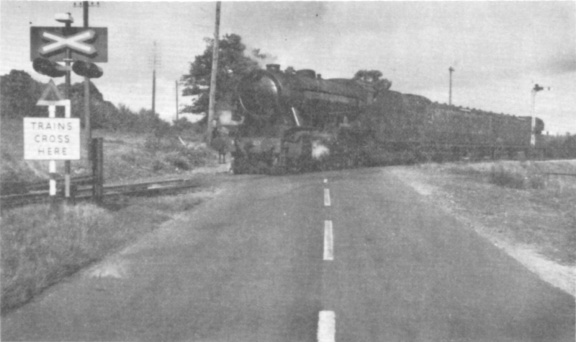
SIR GUY WILLIAMS [North British 25205 of
1943] crossing the Liphook - Grentham road with a train from Liss
in August
1963. (G Moon)
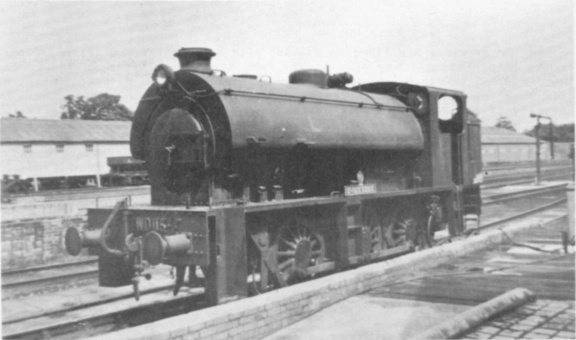
Austerity Sadlletank 118 BRUSSELS
[Hudswell
Clarke 1782 of 1945] at Longmoor Shed in 1963.
Note the electric headlamp and
unusual design of footplate steps. (Author)
The passenger rolling stock normally in use is either a pair of ex−SECR ‘Birdcage’ brake coaches, or a pair of ex−GWR brake coaches fitted with modern plastic seats with tubular metal framing. There are also three ex−SR coaches, one of which has been converted to an Ambulance coach. The freight rolling stock is a motley collection of vehicles of all types. Four wheel vans predominate although there are a fair number of bogie ‘crocodile’ wagons. Apart from several built as recently as 1959, most of the vans formerly belonged to pre-grouping railway companies and a number of older ones look as if they would fall to pieces if they were ever shunted. The remainder of the freight stock consists of open wagons, hopper wagons, brake vans and water tank wagons. I do mot know the exact totals of goods rolling stock, but would estimate them at about 25 vans, 15 ‘crocodile’ wagons, 12 open wagons, 5 brake vans, 3 water tank wagons and 2 hopper wagons. There are also 2 cranes - one a modern 10−ton diesel which is fairly new and the other a huge 45−ton steamer which has a special shed to itself and is capable of lifting a standard ‘Austerity’ saddle tank.
Looking to the future I know more than I am allowed to mention but I think it safe to say that the Longmoor Military Railway will be with us for many more years to come.